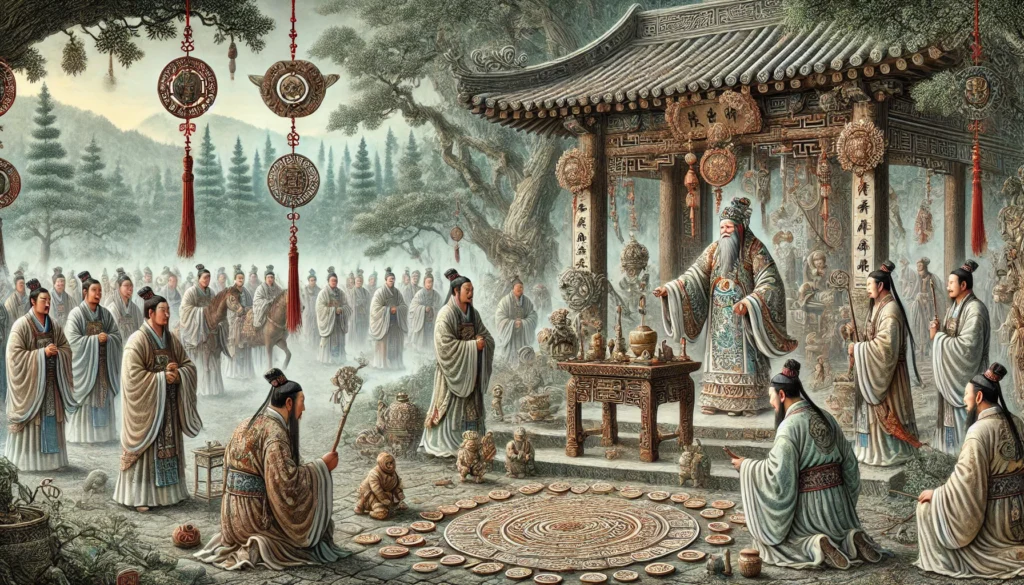The history of “curseology” in Ancient China, especially during the Han Dynasty (206 BCE–220 CE), reveals how beliefs in curses, supernatural forces, and protective rituals were embedded in the culture. The Han Dynasty was a period of significant development in Chinese mysticism and occult practices, and this was influenced by the integration of Confucian, Taoist, and folk beliefs. Here’s a historical perspective on how curse-related practices and beliefs evolved during this era:
1. The Role of Wu (Shamanic Practitioners)
- In the early Han Dynasty, wu, or shamans, held considerable influence in society. They were believed to mediate between the human and spirit worlds, performing rituals to both invoke blessings and counter curses. These shamans often conducted ceremonies to ward off evil spirits, cleanse curses, and protect individuals and families from misfortune.
- Shamanic practices were especially prevalent in rural areas, where natural elements were thought to harbor both benign and malevolent spirits. Wu practitioners used various ritual objects like talismans, animal sacrifices, and incantations to appease these spirits or counteract curses cast by others.
2. Influence of Confucianism and State-Controlled Superstition
- Confucianism became the state ideology during the Han Dynasty, influencing social and moral norms. Confucian scholars generally dismissed curse practices as “unorthodox” or superstitious, but they acknowledged that curses could influence the popular psyche.
- The Han state attempted to control supernatural beliefs, implementing policies against “unofficial” magic and curses. However, emperors themselves often consulted diviners and astrologers, who influenced the court’s approach to curses, omens, and auspicious events. The belief was that certain curses or omens could reflect the Mandate of Heaven, showing approval or disapproval of a ruler’s actions.
3. Emergence of Taoist Practices and Protective Charms
- Taoism flourished during the Han Dynasty, promoting concepts like yin and yang, and the Five Elements theory. Taoists believed that curses could disturb the natural balance, and they developed protective charms, rituals, and alchemical methods to shield against curses.
- Texts like the “Tai Ping Jing” (太平經), or Scripture of Great Peace, contain references to spiritual and protective practices to combat supernatural threats, including curses. Taoist priests and practitioners crafted amulets, talismans, and elixirs intended to ward off evil forces, which were popular among both the elite and common people.
4. Written Curses and Talismans
- The Han Dynasty witnessed an increase in the use of written talismans and curse inscriptions. People would inscribe curses onto pottery shards or small tablets, sometimes burying them near the homes or property of intended victims.
- Common forms of curses included inscribing an enemy’s name and associated hexes onto objects, which were then subjected to destructive rituals (like breaking or burying) to symbolize harm to the intended target. Similarly, talismans inscribed with protective spells were used to counteract such curses.
5. Burial Customs and Anti-Curse Measures in Tombs
- Han tombs were often equipped with protective artifacts designed to prevent curses or harmful spirits from disturbing the deceased. Grave items included jade amulets, mirror charms, and clay figures intended to safeguard the tomb from malicious forces.
- The famous jade burial suits, designed for members of the nobility, were believed to offer protection and prevent the soul from being cursed or desecrated after death. These burial practices reflected an intricate belief system where curses and spiritual threats continued to hold sway even in death.
6. Documentation of Curses in Han Literature
- The Records of the Grand Historian (《史记》), written by Sima Qian, and the Book of Han (《汉书》) document various superstitions, omens, and accounts of curses within Han society. These texts provide insights into the fears and supernatural beliefs prevalent at the time.
- Some stories describe individuals cursed by political opponents or supernatural entities, often leading to misfortune or even death. This literature reflects the high regard for curses and their potential impact, not only as folklore but also as tools of psychological and social influence.
7. Curses as Political and Social Tools
- In the Han court, curses were sometimes used as covert political weapons. The accusation of sorcery or cursing was a tactic used against political rivals, leading to trials, exiles, or executions. Accusations of “witchcraft” or curse-casting could serve as grounds for removing a rival or dissident from power.
- Empress Dowager Lü and Empress Dowager Dou, for example, were rumored to have dealt with alleged curses against them by launching investigations and eliminating suspected sorcerers or dissenters. This practice demonstrated how curses, whether believed in or used as a pretext, held significant political weight.
Legacy and Influence on Later Dynasties
The curse practices, protective charms, and supernatural beliefs from the Han Dynasty shaped later Chinese mystical traditions, including those in the Tang and Song Dynasties. Rituals, Taoist talismans, and shamanic traditions persisted, with curseology remaining a part of China’s cultural fabric for centuries. Han Dynasty “curseology” thus set a foundation for the continued evolution of mystical and protective practices in Chinese history.
